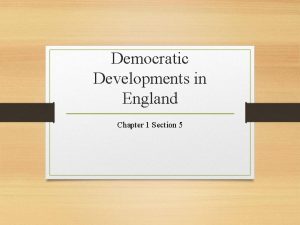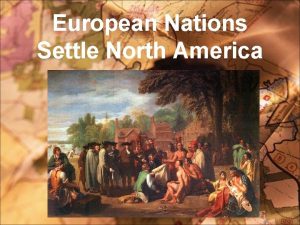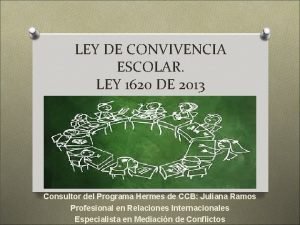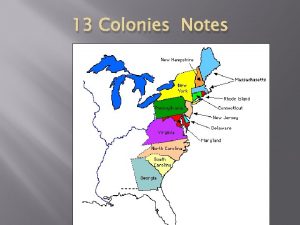Colonial Developments New England 1620 Pilgrims separatists Mayflower










- Slides: 10

Colonial Developments • • • New England 1620 – Pilgrims (separatists) Mayflower Compact 1629 – Mass. Bay Colony Congregationalists (reform from within) John Winthrop – “City on a Hill” Roger Williams/Anne Hutchinson (illustrated religious intolerance) • • Chesapeake 1606 – Jamestown Joint-stock company. John Smith (martial law) John Rolfe – tobacco Maryland – refuge for Catholics Many indentured servants Driven by the pursuit of wealth. Less sense of community.

Road to Revolution (1750 -1776) • Salutary Neglect (1650 -1750) • Mercantilism – Colonies should serve the economic needs of the Crown • Navigation Acts • In 1750, the colonists were loyal British subjects • French/Indian War (1754 -1763) • Brought the colonists into close contact with British soldiers

Benjamin Franklin – Albany Plan (1754)

Impact of the French/Indian War • Anti-British Sentiment • Colonists came into contact with each other • Britain was left with a huge debt • Sought to raise revenue from the colonies.

British Regulation • • Proclamation of 1763 Sugar Act (1764) Currency Act (1764) Stamp Act (1765) Virtual representation Sons of Liberty (1766) Stamp Act repealed (1766) – Declaratory Act

KEY POINT • These new regulations did not directly lead to the American Revolution • Declaratory Act (1766) • Declaration of Independence (1776) • Many questions ask that you demonstrate knowledge of this fact. • Things really started to get a bit hairy after this event…

• • • 1770 Economic Tension Standing army Still no war. But…

Boston Tea Party (1773)

Road to War • Coercive Acts (1773) • First Continental Congress (1774) – still hesitant to declare independence • 1775 – Lexington/Concord • 1775 – Second Continental Congress • Common Sense – Thomas Paine • Declaration of Independence (1776) • Franco-American Alliance (1778)

The New Nation Struggles Articles of Confederation Shows the fear of a strong central government. Unicameral, no executive National government could not tax, regulate trade. Amendments required unanimous consent. Britain refused to abandon military posts. Shay’s Rebellion (1787) One good accomplishment – Land Ordinance of 1785, NW Ordinance of 1787. • Orderly system for territories to become states. • •


















